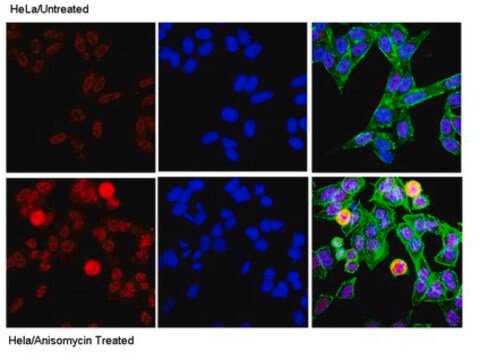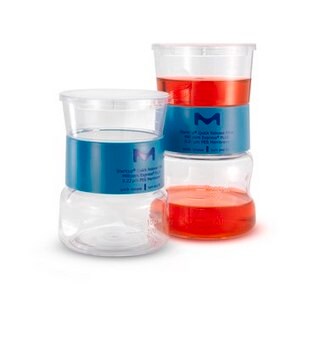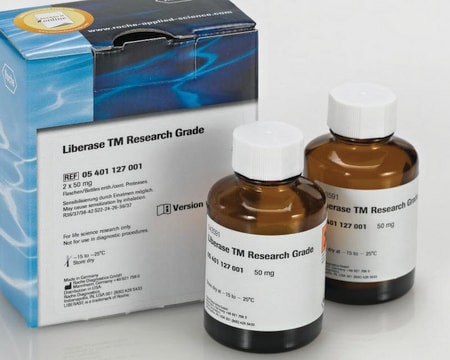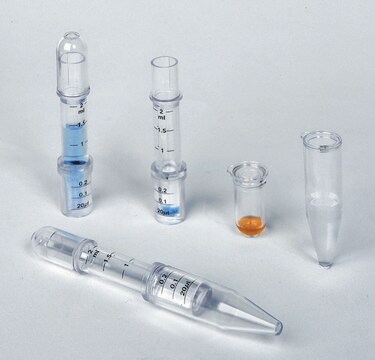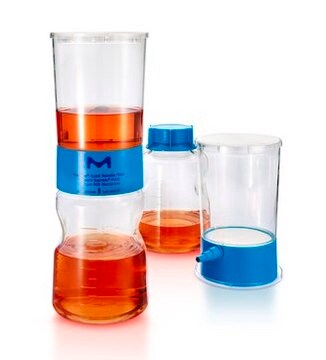추천 제품
생물학적 소스
rabbit
Quality Level
항체 형태
affinity isolated antibody
항체 생산 유형
primary antibodies
클론
polyclonal
정제법
affinity chromatography
종 반응성
mouse, human
기술
immunoprecipitation (IP): suitable
western blot: suitable
NCBI 수납 번호
배송 상태
wet ice
타겟 번역 후 변형
unmodified
유전자 정보
human ... BPTF(2186)
mouse ... Bptf(207165)
일반 설명
Nucleosome-remodeling factor subunit BPTF (UniProt A2A654 and E9Q6A7; also known as Bromodomain and PHD finger-containing transcription factor, Fetal Alz-50 clone 1 protein, Fetal Alzheimer antigen) is encoded by the Bptf (also known as Fac1, Falz) gene (Gene ID 207165) in murine species. BPTF, SNF2L and pRBAP46/48 are the three subunits of the nucleosome-remodelling factor NURF, an ISWI chromatin-remodeling complex that catalyzes ATP-dependent nucleosome sliding. BPTF mediates NURF target site specificity via interactions with transcription factors, histone variants and histone modifications on transcriptionally active genes. BPTF plays an important role in regulating nucleosome occupancy at nucleosome-free regions (NFRs) at sites occupied by the multivalent factors CTCF and cohesin via direct interaction with CTCF and the cohesin subunit SA2. In addition, BPTF also interacts with c-MYC and plays an essential role in its genomic distribution and biological activity. BPTF is necessary for the survival of c-MYC-overexpressing cells and for c-MYC-driven tumorigenesis in the mouse pancreas. BPTF knockdown leads to decreased c-MYC chromatin accessibility and significantly delays tumour development in pre-neoplastic pancreatic acinar cells. Consistently, BPTF expression in human tumours positively correlates with activation of c-MYC gene signatures.
특이성
This rabbit polyclonal antibody detected BPTF in wild-type, but not Bptf-knockout mouse cell lysates. A greatly reduced target band was observed using lysates from BPTF shRNA-treated human HepG2 cells (Qiu, Z., et al. (2015). Mol. Cell. Biol. 35(1):224-237; Courtesy of Joseph Landry, Ph.D, Virginia Commonwealth University School of Medicine, U.S.A.).
면역원
Epitope: N-terminal region.
GST-tagged recombinant mouse BPTF N-terminal fragment.
애플리케이션
Research Category
Epigenetics & Nuclear Function
Epigenetics & Nuclear Function
Research Sub Category
Transcription Factors
Transcription Factors
This rabbit polyclonal Anti-BPTF Antibody has been published and validated for use in Immunoprecipitation and Western Blotting applications.
Western Blotting Analysis: 0.2 µg/mL from a representative lot detected BPTF in 50 µg of human HepG2 cell lysate. BPTF shRNA treatment greatly reduced cellular BPTF level (Courtesy of Joseph Landry, Ph.D, Virginia Commonwealth University School of Medicine, U.S.A.).
Western Blotting Analysis: 0.2 µg/mL from a representative lot detected BPTF in 50 µg of wild-type, but not Bptf-knockout, mouse embryonic fibroblast (MEF) lysate (Courtesy of Joseph Landry, Ph.D, Virginia Commonwealth University School of Medicine, U.S.A.).
Immunoprecipitation Analysis: A representative lot co-immunoprecipitated Ctcf and SA2 with BPTF from mouse embryonic stem cell (mESC) extract (Qiu, Z., et al. (2015). Mol. Cell. Biol. 35(1):224-237).
Western Blotting Analysis: A representative lot detected BPTF in Ctcf and SA2 immunoprecipitates from mouse embryonic stem cell (mESC) extract (Qiu, Z., et al. (2015). Mol. Cell. Biol. 35(1):224-237).
Western Blotting Analysis: A representative lot detected BPTF in ESC, MEF, and CD8+/CD4+ double-positive (DP) thymocytes from wild-type, but not Bptf-knockout, mice (Qiu, Z., et al. (2015). Mol. Cell. Biol. 35(1):224-237).
Note: ABE24 is not recommended for Chromatin Immunoprecipitation (ChIP). For ChIP application, please use ABE1966.
Western Blotting Analysis: 0.2 µg/mL from a representative lot detected BPTF in 50 µg of wild-type, but not Bptf-knockout, mouse embryonic fibroblast (MEF) lysate (Courtesy of Joseph Landry, Ph.D, Virginia Commonwealth University School of Medicine, U.S.A.).
Immunoprecipitation Analysis: A representative lot co-immunoprecipitated Ctcf and SA2 with BPTF from mouse embryonic stem cell (mESC) extract (Qiu, Z., et al. (2015). Mol. Cell. Biol. 35(1):224-237).
Western Blotting Analysis: A representative lot detected BPTF in Ctcf and SA2 immunoprecipitates from mouse embryonic stem cell (mESC) extract (Qiu, Z., et al. (2015). Mol. Cell. Biol. 35(1):224-237).
Western Blotting Analysis: A representative lot detected BPTF in ESC, MEF, and CD8+/CD4+ double-positive (DP) thymocytes from wild-type, but not Bptf-knockout, mice (Qiu, Z., et al. (2015). Mol. Cell. Biol. 35(1):224-237).
Note: ABE24 is not recommended for Chromatin Immunoprecipitation (ChIP). For ChIP application, please use ABE1966.
품질
Evaluated by Western Blot in NIH/3T3 cell lysate.
Western Blot Analysis: 0.05 µg/mL of this antibody detected BPTF in 10 µg of NIH/3T3 cell lysate.
Western Blot Analysis: 0.05 µg/mL of this antibody detected BPTF in 10 µg of NIH/3T3 cell lysate.
표적 설명
~300/250/100 kDa observed. 333.2/321.6 kDa (mouse; UniProt A2A654/E9Q6A7) and 338.3/325.1/322.2 kDa (human isoform 1/2/3; UniProt Q12830) calculated.
물리적 형태
Affinity purified
Purified rabbit polyclonal antibody in buffer containing 0.1 M Tris-Glycine (pH 7.4), 150 mM NaCl with 0.05% sodium azide.
저장 및 안정성
Stable for 1 year at 2-8°C from date of receipt.
분석 메모
Control
NIH/3T3 cell lysate
NIH/3T3 cell lysate
기타 정보
Concentration: Please refer to the Certificate of Analysis for the lot-specific concentration.
면책조항
Unless otherwise stated in our catalog or other company documentation accompanying the product(s), our products are intended for research use only and are not to be used for any other purpose, which includes but is not limited to, unauthorized commercial uses, in vitro diagnostic uses, ex vivo or in vivo therapeutic uses or any type of consumption or application to humans or animals.
적합한 제품을 찾을 수 없으신가요?
당사의 제품 선택기 도구.을(를) 시도해 보세요.
Storage Class Code
12 - Non Combustible Liquids
WGK
WGK 1
Flash Point (°F)
Not applicable
Flash Point (°C)
Not applicable
시험 성적서(COA)
제품의 로트/배치 번호를 입력하여 시험 성적서(COA)을 검색하십시오. 로트 및 배치 번호는 제품 라벨에 있는 ‘로트’ 또는 ‘배치’라는 용어 뒤에서 찾을 수 있습니다.
Aiman S Alhazmi et al.
The Journal of biological chemistry (2018-08-25)
This article has been withdrawn by Aiman Alhazmi, Marissa Mack, Tiffany Rolle, Jordan Hiegel, Syed Haqqani, Nga Dao, Farheen Zaman, Nak-Kyeong Kim, Neel Scarsdale, Charles Lyons, and Joseph Landry. Some of the genome-wide data sets were flawed and were not analyzed
자사의 과학자팀은 생명 과학, 재료 과학, 화학 합성, 크로마토그래피, 분석 및 기타 많은 영역을 포함한 모든 과학 분야에 경험이 있습니다..
고객지원팀으로 연락바랍니다.
